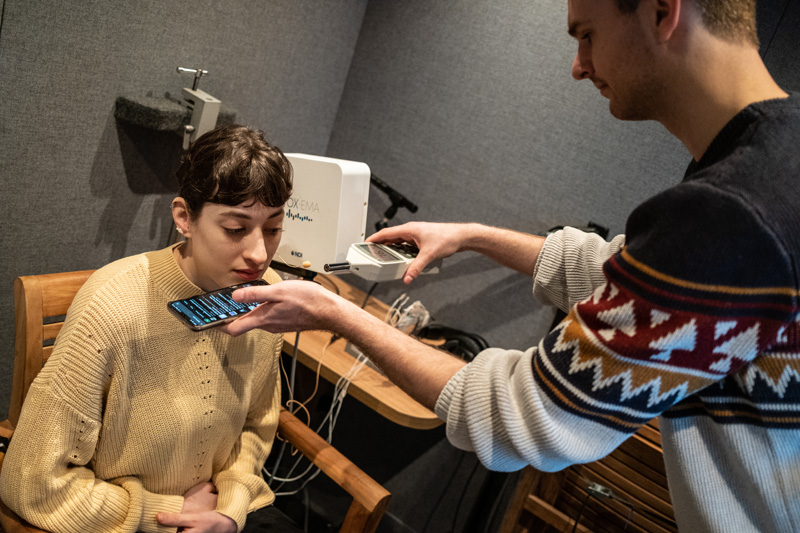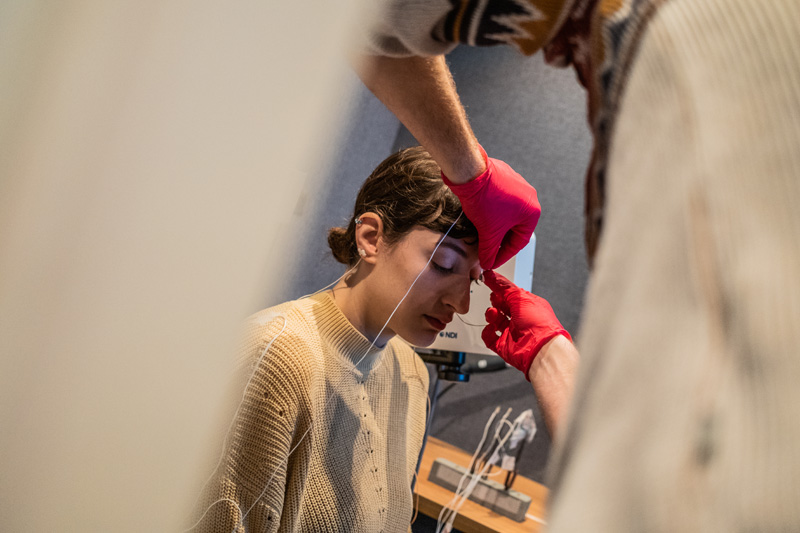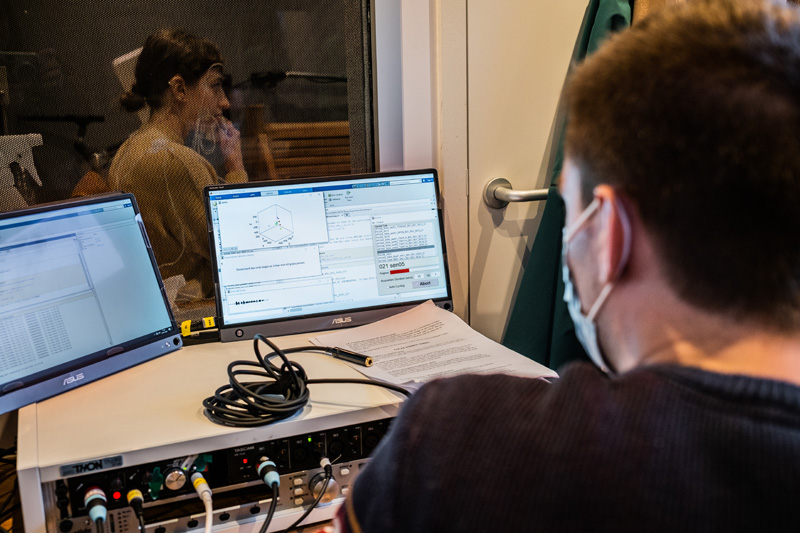
Guinea pigs #6Post-surgery speech adaptation
‘There are even sensors on my tongue’
Today’s experiment has me getting into a white van. As I’m hastily directed towards it, I feel a little worried. But when I get closer, I see that it is a state-of-the-art mobile laboratory. This isn’t some shady operation: the UG logo stuck all over it reassures me that everything will be alright.
‘This is a very cool addition to our research project’, says Thomas Tienkamp, the PhD student who conducts the research. ‘As most of the participants are older adults who have undergone surgery for oral cancer, we can directly drive to their homes for the tests.’
Oral cancer is an umbrella term for tumours on the tongue, jaw, or floor of the mouth, among other places. Surgical treatment may lead to problems with speech and swallowing that could negatively impact someone’s quality of life, and Thomas aims to find out how people’s speech motor system can adapt after an intervention like that.
After doing his bachelor degree in Groningen and a master studies in Amsterdam, Thomas came back to do ‘a PhD that suits me perfectly’. He is part of the Speech Lab group and Speech Biosignal Processing Lab within the Faculty of Arts, which collaborates with the UMCG.
Experiment room
In the van, I see something that looks a bit like a kitchen with a small empty table and some cupboards. To my left is a desk with a computer and a lot of papers, and on the far end of the van is the experiment room: an almost completely sound-attenuated booth where the speech recordings take place.
I’m guided to the experiment room and sit down on a sturdy chair. In front of me, there is a large TV monitor and on my right I see a bunch of white thin cables with sensors, attached to something with metal utensils.
The first part of the experiments kicks off.
Thomas gently puts a pair of headphones on my ears. ‘Do they fit alright?’ he asks. I nod. It’s an exercise where I have to pronounce short words, like ‘bed’ or ‘pet’, but I have to pronounce the vowel for longer while my voice echoes in the headphones.
Next, I get a bite-block between my teeth and my speech transforms into a slight lisp. I now need to pronounce short words again, but besides my new, amusingly altered voice, I also hear a ‘heavy rain’ sound while I read.
Flexible
‘Experiments like these assess how flexible people are in adapting their speech’, Thomas explains afterwards. Our brain automatically compares what we expect to hear and feel to the actual content we produce. ‘For example, if we say the wrong word, we tend to immediately correct ourselves.’
This flexibility is important for people who have been treated for oral cancer, as the surgery causes lasting anatomical changes that often lead to problems with speech. Thomas is interested in whether the ease with which someone can adjust their speech – alongside other variables like tumour size or location – may predict postoperative speech.
‘Can their brain come up with new ways to produce similar sounding speech? Are they more flexible in creating compensatory strategies for their altered anatomy? Could this be trained in any way for speech therapy?’
Motion tracking
For the next part, Thomas and master student Valentina Ciot attach sensors with some tape and dental glue to my face so they can measure my articulation with motion tracking sensors. Wearing rubber gloves and a face mask, Thomas adds the sensors to various regions of my face, my jaw, and even my tongue. The latter one keeps falling off, but finally sticks after several tries.
‘So, what are you going to do after the experiments?’ he asks, pretty off-topic. But it’s part of a mandatory five-minute small talk, which helps me to get used to my new appearance and the slight change in my voice due to the sensor on my tongue.
I do the same experiments as before and surprisingly, I almost forget about the sensors.
‘Although people can have different ways of how their tongue, jaw, and lips are positioned, they can still produce speech that sounds the same’, Thomas explains after the two-hour lab session. ‘By accurately tracking the articulatory movements, we can investigate two things: which sounds are impacted by treatment for oral cancer, and how people compensate.’
With that knowledge, he hopes to help improve speech therapy for this group. ‘It’s surprising how little knowledge there is of how articulatory movements change as a result of an operation, considering the impact that the treatment has on someone’s quality of life’, he says. ‘Speech is inherently human, and not being able to articulate your thoughts and feelings clearly to the people around you can be an incredibly isolating feeling.’
- Faculty: Arts
- Duration: 2 hours
- Remuneration: 20 euros



